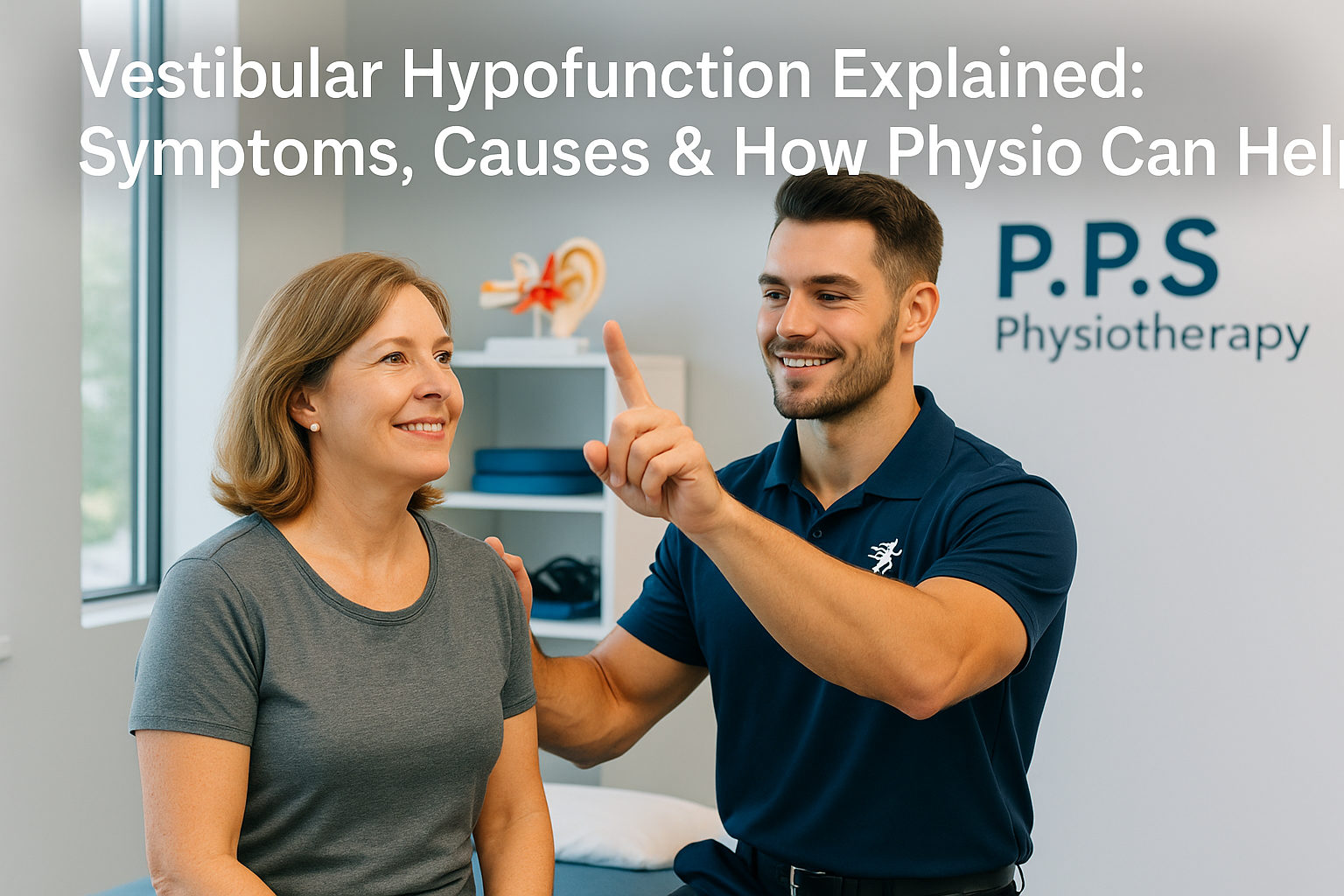Vestibular Hypofunction Explained: Symptoms, Causes & How Physio Can Help
Feeling dizzy, off-balance, or struggling to walk in a straight line? You may be experiencing vestibular hypofunction. At P.P.S Physiotherapy, we offer vestibular hypofunction treatment in Kellyville and Carlingford, helping people regain control, balance, and confidence every day.
In this blog, we’ll explain what vestibular hypofunction is, how it’s diagnosed, and most importantly, how vestibular physiotherapy can help you regain control, stability, and confidence.
What is Vestibular Hypofunction?
Vestibular hypofunction is a condition where the inner ear’s balance system—the vestibular system—no longer functions as it should. As a result, your brain receives confusing signals about motion and balance. Think of it like your body’s internal “gyroscope” that helps you stay upright and stable. When this system malfunctions, your brain receives confusing signals about motion and balance, resulting in dizziness and unsteadiness.
There are two main types, each with unique characteristics:
- Unilateral vestibular hypofunction (UVH): One ear is affected.
- Bilateral vestibular hypofunction (BVH): Both ears are affected—often more severe and longer-lasting.
This condition is more common than many realise, particularly in adults aged 40–70+ living in areas like NW Sydney.
Common Symptoms of Vestibular Hypofunction
Symptoms can vary but typically include:
- Persistent dizziness or a sense of spinning
- Unsteady walking—especially in dark or uneven environments
- Blurry vision with head movement (called oscillopsia)
- Fatigue or motion sensitivity
Patient example: Margaret, a 62-year-old from Carlingford, noticed she couldn’t walk straight in low light and had difficulty reading while moving. After an assessment at PPS, our team diagnosed Margaret with unilateral vestibular hypofunction and she improved within 6 weeks of targeted rehab.
How Vestibular Hypofunction Differs from Other Conditions
| Condition | Key Symptoms | Typical Duration |
|---|---|---|
| Vestibular Hypofunction | Dizziness, unsteadiness, blurred vision | Ongoing (until treated) |
| BPPV | Brief vertigo triggered by head movement | Seconds to minutes |
| Meniere’s Disease | Vertigo + hearing loss + ear fullness | Episodes lasting hours |
Causes & Risk Factors
Vestibular hypofunction can be caused by:
- Inner ear infections (e.g. vestibular neuritis)
- Aging (degeneration of the vestibular nerve)
- Head injuries or concussions
- Autoimmune conditions or ototoxic medications
Sometimes, no clear cause is found. Nevertheless, physiotherapy can still lead to significant improvements.
These underlying conditions often result in the need for vestibular hypofunction treatment in Kellyville or Carlingford, where our physios offer personalised care plans.
How is Vestibular Hypofunction Diagnosed?
At PPS Physiotherapy, diagnosis begins with a detailed assessment. Our vestibular-trained physiotherapist may perform:
- Head impulse test (to assess VOR function)
- Dynamic visual acuity testing
- Balance and gait analysis
Learn more about our vestibular diagnostic services here.
Treatment Options for Vestibular Hypofunction
Vestibular Rehabilitation Therapy (VRT)
The gold-standard treatment is vestibular rehab therapy (VRT), a customised program designed to retrain your brain and improve balance. At PPS, our VRT includes:
- Gaze stabilisation exercises to improve vision with head movement
- Balance training to reduce falls and boost coordination
- Walking drills and head-turn tasks
Why Choose Physiotherapy Over Medications?
While medication often only masks symptoms, physiotherapy addresses the root cause through neuroplasticity. Studies have found that over 80% of patients significantly improve with VRT within 6–12 weeks.
Vestibular Hypofunction Treatment in Kellyville and Carlingford at P.P.S Physiotherapy – Why Patients Choose Us
- 10+ years’ experience treating complex vestibular disorders
- Convenient locations in Kellyville and Carlingford
- 1-on-1 tailored care in a calm, supportive environment
Our vestibular physiotherapists have postgraduate training and regularly collaborates with GPs, ENTs, and neurologists to optimise outcomes.
Margaret’s Story: “After struggling for months, I was back to walking confidently within weeks. Thank you to the team at PPS Physiotherapy Carlingford!”
Book Your Vestibular Assessment Today
Whether you’re in Kellyville, Carlingford, or NW Sydney, our team is ready to help you with vestibular hypofunction treatment that’s evidence-based and outcome-driven.

Frequently Asked Questions
1. How long does vestibular hypofunction recovery take?
Most people improve within 6 to 12 weeks of starting vestibular rehab, although some complex cases may take longer.
2. Can vestibular hypofunction be cured?
While the damage itself may be permanent, symptoms can improve dramatically with neuroplastic retraining via vestibular rehab therapy.
3. Do I need a referral?
No referral is needed to see a vestibular physiotherapist at PPS, although we regularly collaborate with GPs and ENTs.
Trusted by Locals in Kellyville, Carlingford & NW Sydney
Over time, PPS Physiotherapy has become the go-to vestibular clinic for patients across Baulkham Hills, Castle Hill, West Pennant Hills, Glenhaven and surrounding suburbs.
Ready to Improve Your Balance? Then It’s Time For Effective Physiotherapy for Vestibular Hypofunction Treatment in Kellyville & Carlingford
Contact PPS Physiotherapy in Carlingford or PPS Physiotherapy in Kellyville today to schedule your appointment with one of our physiotherapists. Start your journey to better balance, reduced dizziness, and improved quality of life. Book Your Appointment for Vestibular Hypofunction Treatment Today
Explore more:

